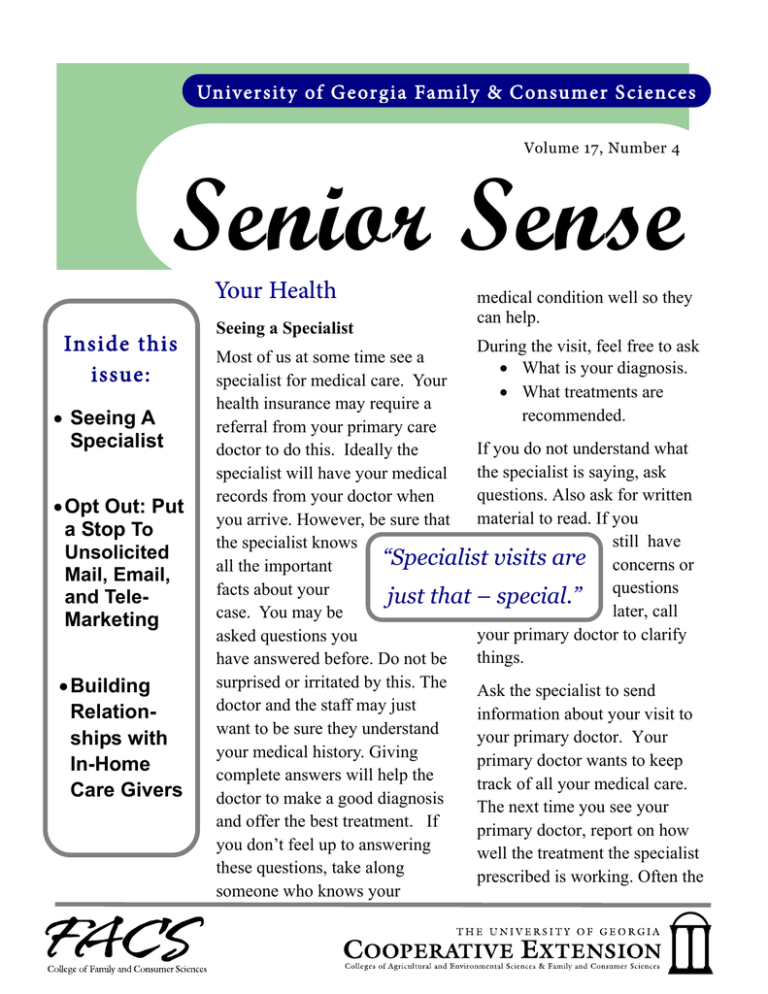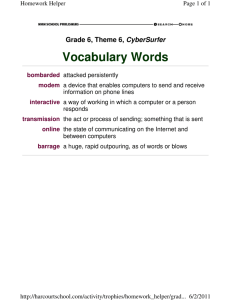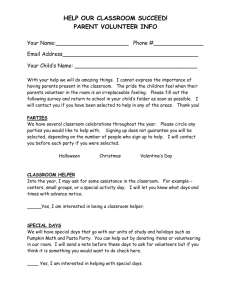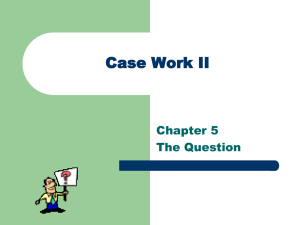Senior Sense Your Health Inside this
advertisement

University of Georgia Family & C onsumer S ciences Volume 17, Number 4 Senior Sense Your Health Inside this issue: • Seeing A Specialist • Opt Out: Put a Stop To Unsolicited Mail, Email, and TeleMarketing • Building Relationships with In-Home Care Givers Seeing a Specialist medical condition well so they can help. During the visit, feel free to ask Most of us at some time see a • What is your diagnosis. specialist for medical care. Your • What treatments are health insurance may require a recommended. referral from your primary care If you do not understand what doctor to do this. Ideally the the specialist is saying, ask specialist will have your medical questions. Also ask for written records from your doctor when material to read. If you you arrive. However, be sure that still have the specialist knows “Specialist visits are concerns or all the important facts about your just that – special.” questions later, call case. You may be your primary doctor to clarify asked questions you things. have answered before. Do not be surprised or irritated by this. The Ask the specialist to send doctor and the staff may just information about your visit to want to be sure they understand your primary doctor. Your your medical history. Giving primary doctor wants to keep complete answers will help the track of all your medical care. doctor to make a good diagnosis The next time you see your and offer the best treatment. If primary doctor, report on how you don’t feel up to answering well the treatment the specialist these questions, take along prescribed is working. Often the someone who knows your Page 2 specialist will only see you once or twice, but will then expect your primary doctor to handle your long-term treatment. Specialist visits are just that – special. Make the most of them by describing your symptoms and past treatments for your condition as thoroughly as possible. Strawberry-Rhubarb Cobbler This recipe for strawberry-rhubarb cobbler uses whole wheat flour and oil instead of all white flour and shortening or butter in the dough. These changes increase the fiber and decrease the trans fat content of the recipe. If you need to cut the sugar, substitute an artificial sweetener equal to ½ cup sugar in the filling. Keep the sugar in the dough to maintain the desired texture. Makes 6 servings For the Biscuit Topper: ½ cup whole wheat flour ½ cup all purpose flour 2 tablespoons sugar 1 ½ teaspoons baking powder 2 tablespoons canola oil 1 egg, slightly beaten or 1/4 cup low cholesterol egg substitute ¼ cup non-fat milk Senior Sense For the Filling: 2 cups fresh or frozen rhubarb, cut into 1-inch pieces 2 cups fresh or frozen sliced strawberries, no sugar added 2 tablespoons cornstarch 1 tablespoon water 1 tablespoon light margarine, melted To Make Biscuit Topping: 1. Combine the flours, 2 tablespoons of sugar, and baking powder in medium bowl. 2. Add the canola oil and cut with pastry cutter until flour mixture resembles coarse crumbs. 3. Mix the egg and milk together and pour into dough mixture all at once. Stir until dry ingredients are just moistened. Set aside. To Make Filling: 1. Combine sugar with rhubarb and strawberries in a medium sauce pan. 2. Mix the cornstarch with the water and margarine to make a paste. Stir into the fruit. 3. Bring to a boil stirring constantly. Cook and stir for one minute or until thickened. To Assemble Cobbler: 1. Pour filling into 8-inch round cake pan. Senior Sense 2. Drop 6 mounds of the biscuit topper onto the filling. 3. Bake in pre-heated 400 degrees oven for 20-25 minutes or until biscuit is brown and filling is bubbly. 4. Cool slightly before serving topped with a little plain non-fat yogurt. Nutrition Information with sugar and regular whole egg: Calories: 311 Carbohydrate: 61 grams Protein: 4 grams Fat: 6 grams Saturated Fat: 0.07 grams Cholesterol: 35 milligrams Sodium: 96 milligrams Fiber: 3 grams Nutrition Information with sugar substitute and low cholesterol egg substitute: Calories: 174 Carbohydrate: 30 grams Protein: 4 grams Fat: 5 grams Saturated Fat: Less than .5 grams Cholesterol: Less than 0.5 mg Sodium: 104 milligrams Fiber: 3 grams Your Resources Opt Out: Put A Stop To Unsolicited Mail, Email, And Telemarketing A typical visit to the mailbox: power bill, credit card bill, letter from a dear friend Page 3 credit card offer, pre-qualified home equity loan offer, and a sweepstakes offer. Usually we know we will receive notices that we owe someone money (our bills) and also a little junk. If you are somewhat concerned or just annoyed by the amount of offers you receive, you can eliminate much of the extra in your mailbox and even reduce your email volume and telephone calls. Pre-screened or pre-qualified offers of credit are based on information from your credit report. To get your information, creditors search the credit bureau databases for names and addresses of consumers that meet their qualifications or criteria. This results in credit card, loan, and even insurance offers in the mail and even email. If you decide you do not want to receive these offers, you have two opt-out options: a five-year opt out or a permanent one. For either option, you can call toll-free 1-888-5-OPTOUT. (1-888-5-678687) This is a service operated by the three major credit bureaus, Equifax, Experian, and TransUnion. It takes your information out of the available database creditors use to get information. In addition, you may contact the credit bureaus directly. Page 4 Senior Equifax, Inc. S ense Options PO Box 740123 Atlanta, GA 30374-0123 Senior Sense but there is a $5 charge for online registration. With modern technology, the mailbox is not the only place where you may receive junk or unsolicited offers. More frequently, email and telemarketing Experian are used to solicit consumers. The CANConsumer Opt-Out SPAM Act 701 Experian Parkway (Controlling the “You can eliminate much of the Allen, TX 75013 Assault of NonTransUnion extra in your mailbox and even Solicited Name Removal Option reduce your email volumn…” Pornography and PO Box 505 Marketing Act) of Woodlyn, PA 19094 2003 establishes requirements for those The Direct Marketing Association who send commercial emails. It requires (DMA) maintains a service that lets you that email give recipients an opt-out opt-out of direct mail marketing from method included in each email message. many national companies for a five-year Once the company receives an opt-out period. When you register with the request, the law allows ten business days DMA, your name is included on a delete for the emails to cease. You can opt out of file that is made available to direct-mail emails from DMA members through their marketers. Unfortunately, this only e-mail preference service (e-MPS) by covers mail from companies that are visiting registered with DMA, but it can help to http://www.dmaconsumers.org/optoutform reduce the junk in your mailbox. To _emps.shtml and it remains effective for register for the service free-of-charge, two years. send a letter with your name, address and The National Do Not Call Registry signature to: covers unsolicited telephone calls. This is Direct Marketing Association a free service provided to reduce Mail Preference Service telemarketing calls. To register, call 1PO Box 643 888-382-1222 from the phone number Carmel, NY 10512 you want to register or visit You can also register online at www.thewww.donotcall.gov. dma.org/consumers/offmailinglist.html, Senior Sense Your Relationships Building Relationships With In-Home Care Helpers Page 5 expectations? If you have limited experience in training and supervising people, it is natural to feel some anxiety about establishing a good working relationship with the new care helper and about making some mistakes in communication and cooperation with her. Here are some steps for establishing effective, friendly working relationships with in-home care providers. Silas and Ginny had been married more than 50 years and had made a wonderful life together. In recent years, however, Ginny’s abilities to take care of things around the house had grown more limited. Cooking and laundry were particular challenges. Step 1. Orientation: Before the first Silas did more and more of what he could, day of work, consider inviting the helper but he was getting older too. They wanted into your home for a cup of coffee. This to stay in their home and community as may help get things long as possible, so they off to a good start “A good relationship with a decided to hire a helper building relationships to come into their home hired caregiver is a vital between family daily. caregivers, a care part of enhancing the In-home helpers can receiver, and the new quality of in-home care and provide a whole range of worker through a services, from basic face-to-face meeting. your loved one’s well-being.” housekeeping all the way This orientation could to help with complex medical care. Some also happen on the first day or work. work only a few hours a week and others Showing the layout of the home will provide care around the clock. Even though provide the helper with the chance to they are paid as an employee, because they learn where essential things are kept and work right in the home, they often become how to operate needed appliances for infriends and confidants as well. A good home care. Clearly describe your and relationship with a hired caregiver is a vital your loved one’s task expectations, part of enhancing the quality of in-home routines, and preferences. Provide a care and your loved one’s well-being. How contact list and information for handling can you grow comfortable with a new paid emergency events, give clear instructions helper while also being clear about her for needed appliances, and suggest tips Page 6 Senior Sense for creating a good relationship with your loved one. Step 2. Training or Coaching a New In-Home Helper: It takes some time for the new in-home helper to adjust and perform tasks in the way that you and your loved one want. Remember that not everyone folds the sheets or washes the dishes the same way! Through your training and coaching, the new helper will understand what you and your loved one need and expect from her. In addition, this will form the foundation of developing a good working relationship with the helper. Here is the five-step process for training a new helper to do an in-home care task. • Tell the helper how to do the task. If you want a task done in a certain way, explain why. For instance, if your loved one wants the bath towels folded a certain way, tell the helper that this helps him or her maintain a sense of control and order over what might feel like an unmanageable situation. The helper should do things the way you want them done. • Show the worker how to do the task. For example, Silas demonstrates how to cook two poached eggs which Ginny likes for breakfast. “Ginny likes two poached eggs for breakfast. She won’t eat scrambled or fried eggs. She likes her eggs poached a certain way. When I do it, I start with about 2 inches of water in this frying pan. Then, I….” It is a good idea to write down step-by-step instructions for the helper. • Have the helper perform the task while you observe. Tactfully give feedback, and coach the helper when it seems needed. • Praise progress. Notice and acknowledge even modest gains in skills. Give the helper a chance to ask questions. A person is more likely to feel comfortable asking questions in an open, nonthreatening atmosphere. Step 3. Supervising In-Home Help: For a better cooperation between the helper and you, try to talk regularly with the helper about her performance and possible ways to improve. The following positive communication skills will help you communicate effectively and cooperate with the helper. Page 7 Senior Sense • Offer meaningful praise. Give the helper feedback on tasks done well. Praise immediately and be specific. For example: “I appreciate the special effort you made to find Mother’s favorite sweater instead of substituting the one in the drawer that she doesn’t like as well. Thank you.” • Handle problems constructively. Although correcting substandard work can be awkward, give feedback as soon as possible. For example: “I noticed today that Mom’s pill bottles were out on the table. Remember that it is important to keep them in the cabinet. Do you understand?” State exactly what was done incorrectly and offer suggestions for improvement. Keep criticism brief, give specific instructions, and demonstrate the way you want a task done. Use a calm, matter-offact tone of voice. Try to be objective and show confidence that the work will improve. • Listen to the helper. Communication between you and the helper means that you and she discuss concerns and changes and make plans together. Therefore, it is important for you to listen to her opinions, feelings, and suggestions. Try to understand her perceptions and point of view. Seeking feedback is a positive and effective way to prevent and reduce problems. During talks with the helper, if her remarks concern you, it may be a good idea to take some time to think them over before responding. • Be sensitive to slipping performance. It is not uncommon for helpers to do excellent work early on, only to begin cutting corners over time. It is your responsibility to set the standards of help that you expect. If you see the quality of work slipping significantly, don’t let it continue without discussing it with the helper. The collaboration with an in-home helper doesn’t always come easily. Open communication and mutual respect are helpful for establishing an effective working relationship. In a good teamwork climate, you will develop the knowledge and confidence necessary to provide quality care to your loved ones at home. You don’t need to feel alone in struggling with caregiving issues and negative emotions. Adpated from Pacific Northwest Extension, “Hiring and working successfully with in-home care providers.” Page 8 Senior Sense Dear Friend, SENIOR SENSE is a quarterly publication provided by your local county Cooperative Extension office. It is prepared by Extension Family & Consumer Sciences specialists at The University of Georgia specifically for the educational needs of older Georgians. Please contact your local Cooperative Extension office for more information on these and related topics. About Our Organization The University of Georgia and Ft. Valley State University, the U.S. Department of Agriculture and counties of the state cooperating. The Cooperative Extension Service offers educational programs, assistance and materials to all people without regard to race, color, national origin, age, sex, or disability. For large print, taped or Braille editions of this publication, contact the author. An Equal Opportunity/Affirmative Action Organization Committed to a Diverse Work Force Issued in furtherance of Cooperative Extension work, Acts of May 8 and June 30, 1914, The University of Georgia College of Agricultural and Environmental Sciences and the U.S. Department of Agriculture cooperating. J. Scott Angle, Dean and Director Laura D. Jolly, Dean and Associate Director UGA FACS Cooperative Extension Phone: 1-800-ASK-UGA1 Contributors to this issue: Connie Crawley, MS, RD, Extension Nutrition and Health Specialist Michael Rupured, Consumer Economics Extension Specialist Don Bower, Ph.D., CFCS, Extension Human Development Specialist and Wonjee Cho, CFD doctoral student Past editions of Senior Sense are available at: http://www.fcs.uga.edu/ext/pubs/ CHFD-E -95 COOPERATIVE EXTENSION U.S. DEPARTMENT OF AGRICULTURE THE UNIVERSITY OF GEORGIA COLLEGES OF AGRICULTURAL AND ENVIRONMENTAL SCIENCES & FAMILY & CONSUMER SCIENCES ATHENS, GEORGIA 30602 ______________ OFFICIAL BUSINESS November, 2009







